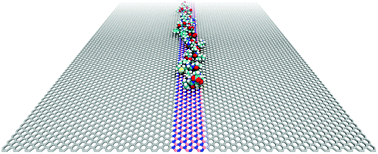Planar graphene/h-BN/graphene heterostructures for protein stretching and confinement†
Abstract
Protein stretching and confinement in nanochannels is critical for advancing single-molecule detection techniques. For standard nanochannels integrated with nano-sensors, reducing their cross-section is beneficial for reading highly localized signals with minimal error, but results in increasing difficulty for the initial capture of any chain molecules due to the entropy barrier. Using molecular dynamics simulations, we show that spontaneous protein stretching can be realized by a two-dimensional (2D) heterostructure composed of a hexagonal boron nitride (h-BN) nanoribbon stitched with two graphene (GRA) sheets (i.e., a sandwiched GRA/BN/GRA structure). Due to fast protein diffusion on its flat surface and adsorption potential difference between two 2D materials, this planar nanochannel permits effective capture and elongation of three representative intrinsically disordered proteins including amyloid-β (1–42), polyglutamine (42) and α-synuclein (61–95). Moreover, we found that the extremely narrow h-BN stripe can provide stronger confinement for a longer polyglutamine chain after being stretched. Our approach has the potential to facilitate the bona fide readout of single-molecule protein sequencing techniques.



 Please wait while we load your content...
Please wait while we load your content...